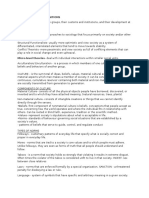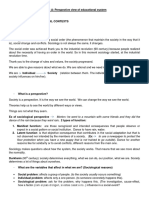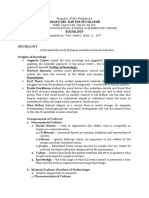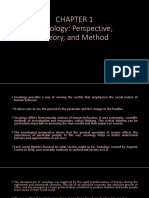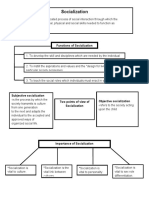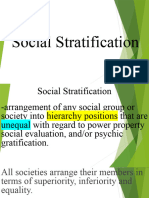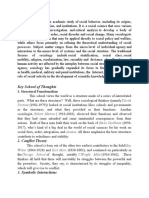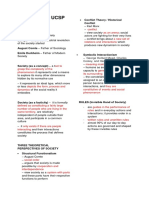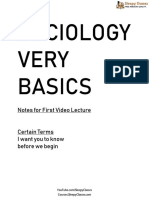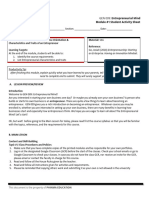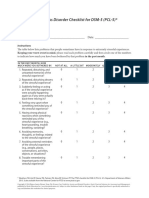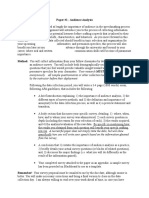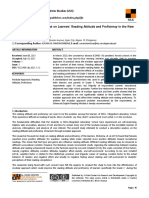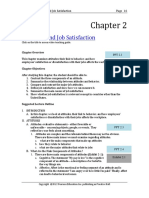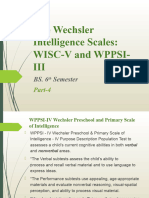Transcript of NMAT SOCIAL SCIENCE COMPONENTS OF CULTURE
Material Culture- consists of all the physical objects people have borrowed,
discovered, or invented and to which they have attached meaning. (natural
SOCIAL SCIENCE
resources, trees, plants)
SOCIOLOGY
is a scientific study of human society and its origins, development,
organizations, and institutions. It is social science which uses various methods
Non-material culture- consists of intangible creations or things that we cannot
of empirical investigation and critical analysis to develop a body of knowledge
identify directly through the senses. (e.g. beliefs, values, norms, folkways, and
about human social activity, structures, and functions.
mores)
SOCIAL SCIENCE THEORIES
COMPONENTS OF NON-MATERIAL CULTURE
Macro-level theories- approaches to sociology that focus primarily on society
•Beliefs- first component of nonmaterial culture is beliefs, conceptions that
and/or other large social units.
people accept as true, concerning how the world operates and where the
individual fits in relationship with others. Can be rooted in blind faith,
STRUCTURAL-FUNCTIONALISTS- usually more optimistic and view
experience, tradition or the scientific method.
society as a system of differentiated, interrelated elements that tend to move
•Values- represent society’s stipulations about what is acceptable in life.
towards stability.
•Norms- standards of behaviour governing social situations that are
established by a society’s values.
CONFLICT THEORISTS- more pessimistic and view society as full of
confliting elements that can play a role in social change and even upheaval.
TYPES OF NORMS
1.Folkways- customary patterns of everyday life that specify what is socially
Micro-level theories- deal with individual interactions within smaller social
correct and proper in everyday life.
units.
2.Mores- Norms that are tied to a society’s core values and to which people
must adhere. Unlike folkways, they are seen as forms of truth that all people
ACCULTURATION/ ENCULTURATION
should understand and follow.
- is a process in which members of one cultural group adopt the beliefs and
3.Taboos- is a norm that society holds so strongly that violating it results in
behaviors of another group.
extreme disgust. Often times the violator of the taboo is considered unfit to
EXAMPLES:
live in that society.
•Picking up a southern American accent within a day or two
INCEST- sex between close relatives
•Sushi becoming popular in the West
4. Laws- norms that are enforced formally by a special organization.
•The granddaughter of a Chinese immigrant has gone to American schools
-SANCTION - a threatened penalty for disobeying a law or rule.
and will now attend an American college. She spends time primarily with her
5. Language- system of symbols that have specific and arbitrary meaning in a
American friends, dresses as they do and shares their values and interests. She
given society.
has become highly acculturated into American culture.
CHARACTERISTICS OF CULTURE
CULTURE
1. ordered, systematic, and integrated
-is the sum total of ideas, beliefs, values, material cultural equipments and non-
2.shared
material aspects which man makes a member of society. (E.B. Taylor 1860s)
3.Weakly Bounded
-Culture can be conceived as a continuous, cumulative reservoir containing
4.Learned
both material and non-material elements that are socially transmitted from
5.Symbolic and is Found in Our behaviour
generation to generation.
6.Fluid and is Changing
�7.Varied CLOSED CLASS SYSTEM
8.Political have been confined to their ancestral occupations, and
9.Corporate their social status has mostly been prescribed by birth.
SUB-CULTURE Most closed class systems are found in less industrialized countries.
refers to attitude of certain group from the habitual practices of the An example of a closed class system with limited social mobility is French
majority.(e.g. new styles of dressing, language and other practices of a group of society before the French Revolution.
people which are different from other majority) Under the Ancient Régime, French society was divided between the first estate
(clergy), second estate (nobility), and third estate (commoners).
Members of each estate were likely to socialize only with others in the same
group.
STEREOTYPE
is any commonly known public belief
about a certain social group or a type of individual.
ASCRIBED STATUS
GENDER STEREOTYPES The social status of a person that is given from birth or assumed involuntarily
SEXUAL ORIENTATION STEREOTYPES later in life.It is the social position one is born into and personal characteristics
Stereotypes are regarded as the most cognitive component, prejudice as the beyond one's control, such as race and gender.
affective and discrimination as the behavioral A social status of a person that is acquired, such as being an Olympic athlete,
SOCIAL CHANGE being a criminal, or being a college professor. It is one's social standing that
is a complex and multi-faceted phenomenon. There are both endogenous depends on personal accomplishments.
(internal to the society concerned) and exogenous (external to the
society)factors influencing social change.Many people interact initially with the ACHIEVED STATUS
stereotype rather than with the true person. In an open class system, people are ranked by achieved status, whereas in a
closed class system, people are ranked by ascribed status.
SOCIAL STRATIFICATION
-is the socioeconomic layering of society's members according to property, STRUCTURAL MOBILITY
power, and prestige. -Opportunity for movement in social class that is attributable to changes in the
social structure of a society, rather than to changes in an individual.
SOCIALIZATION
is the lifelong process of learning how to become functioning, contributing PRIMARY FUNCTION OF RELIGION IN HUMAN SOCIETY
members of society. is to establish an orderly relationship between man and his surroundings.
It is through this mechanism that the heritage and culture of a society can be
passed on from generation to generation. This allows society to survive and CASTE SYSTEM
even proliferate beyond the lifespan of individual members. - is a form of social stratification characterized by endogamy, hereditary
transmission of a style of life which often includes an occupation, ritual status
OPEN CLASS SYSTEM in a hierarchy, and customary social interaction and exclusion based on cultural
is an economic system that has upward and downward mobility, notions of purity and pollution.
is achievement-based, and allows social relations between the classes.
Industrialized nations tend to have open class systems
.
�CONFORMITY
is an individual’s adopting of attitude and behaviours of others because of TYPES OF INTERGROUP INTERACTION
pressure (real or imagined) to do so. 1. ASSIMILATION
Example, a cheerleader who wants to do an original routine but goes along 2. PLURALISM
with the majority of the squad in voting to do a stolen routine exhibits 3. SEGREGATION
conformity. 4. DOMINATION
Conformity can be positive or negative. 5. POPULATION TRANSFER / EXPULSION
6. ANNIHILATION
ROLE STRAIN
happens when contradicting rolesfor the same status are both tried to be MARXIST’S MODEL OF SOCIETY
attained. A teacher very friendly with her students but must grade them is an economic and sociopolitical worldview and method of socioeconomic
objectively can succumb torole strain; although it is possible to maintain both inquiry based upon a materialist interpretation of historical development, a
role prescriptions, it can also lead to psychological stress dialectical view of social change, and an analysis ofclass-relations within society
and their application in the analysis and critique of the development of
TWO ORDERS OF SOCIAL ORGANIZATION capitalism.
PRIMARY GROUP The most valid criticism of Marxist’s model of society is the overemphasis on
SECONDARY GROUP the importance of economic
class to explain historical trends.
BUREAUCRACY
Relationships among members: - By Max Weber; A bureaucracy is a system of organization noted for
There is emphasis on the efficiency by which people accomplish their jobs.It is its size and complexity. Everything within a bureaucracy —
unlikely that every member is aware of every other member. responsibilities, jobs, and assignments — exists to achieve some goal.
The goal is to provide for the personal needs of the members. SIX CHARACTERISTICS OF BUREAUCRACY
- Hierarchy - Focus
- Rules - Impersonal
- Function - Qualification
THREE DIMENSIONS OF WEBER’S NOTION OF SOCIAL CLASS:
economic resources; COMMUNISM
political power, -An equal society, without social classes or class conflict, in which the means
social prestige of production are the common property of all.
FASCISM CAPITALISTS
is a form of radical authoritarian nationalism. Fascists seek to unify their nation The social class of owners of the means of production in industrial societies,
through a totalitarian state whose primary purpose is to make profits.
that seeks the mass mobilization of the national community, relying on a SOCIALISM
vanguard party to initiate a revolution to organize the nation on fascist is an economic system characterized by social ownership of the means of
principles.It promotes regulated private enterprise and private property production and co-operative management of the economy. "Social ownership"
contingent whenever beneficial to the nation and state enterprise and state may refer to cooperative enterprises,
property where private enterprise and private property is unable to meet the common ownership, state ownership, or citizen ownership of equity.
nation's needs.
�NEUROTRANSMITTER EGO DEFENSE MECHANISMS
are endogenous chemicals that transmit signals from a neuron to a target cell 1.Conversion: the expression of an intrapsychic conflict as a physical
across a synapse symptom; some examples include blindness, deafness, paralysis, or numbness.
acetylcholine 2. Denial: Refusal to accept external reality
dopamine 3. Displacement: Defense mechanism that shifts sexual or aggressive impulses
serotonin to a more acceptable or less threatening target; redirecting emotion to a safer
outlet
gamma aminobutyric acid (GABA)
4. Hypochondriasis: An excessive preoccupation or worry about having a
glutamate serious illness.
epinephrine and norepinephrine 5. Isolation: Separation of feelings from ideas and events, for example,
endorphins describing a murder with graphic details with no emotional response
enkephalins 6. Reaction formation: Converting unconscious wishes or impulses that are
EXTRASENSORY PERCEPTION (ESP) perceived to be dangerous into their opposites
involves reception of information not gained through the recognized physical 7. Regression: Temporary reversion of the ego to an earlier stage of
senses but sensed with the mind. development rather than handling unacceptable impulses in a more adult way.
The term was adopted by Duke University psychologist J. B. Rhine. 8.Repression: The process of attempting to repel desires towards pleasurable
ESP is also sometimes casually referred to as a sixth sense, gut instinct or instincts, caused by a threat of suffering if the desire is satisfied; the desire is
hunch, intuition. The term implies acquisition of information by means moved to the unconscious in the attempt to prevent it from entering
external to the basic limiting assumptions of science, such as that organisms consciousness
can only receive information from the past to the present. 9. Undoing: A person tries to 'undo' an unhealthy, destructive or otherwise
threatening thought by acting out the reverse of unacceptable.
TYPES OF EXTRASENSORY PERCEPTION 10. Withdrawal: Withdrawal is a more severe form of defence. It entails
1. CLAIRVOYANCE- is used to refer to the ability to gain information about removing oneself from events, stimuli, interactions, etc. under the fear of
an object, person, location or physical event through means other than the being reminded of painful thoughts and feelings.
known human senses, a form of extra-sensory perception. 11. Identification: The unconscious modelling of one's self upon another
2. TELEPATHY- is the transmission of information from one person to person's character and behaviour.
another without using any of our known sensory channels or physical 12. Introjection: Identifying with some idea or object so deeply that it becomes
interaction. a part of that person.
3. Psychokinesis/telekinesis- "distant-movement" with respect to strictly 13. Sublimation: Transformation of negative emotions or instincts into
describing mental movement or motion of solid matter, is a term coined by positive actions, behaviour, or emotion.
publisher Henry Holt to refer to the direct influence of mind on a physical 14.Thought suppression: The conscious process of pushing thoughts into the
system that cannot be entirely accounted for by the mediation of any known preconscious; the conscious decision to delay paying attention to an emotion
physical energy. or need in order to cope with the present reality
4. PRECOGNITION- precognition (from the Latin præ-, “before,” + 15.Somatization: The transformation of negative feelings towards others into
cognitio, “acquiring knowledge”), also called future sight, and second sight, is a negative feelings toward self, pain, illness, and anxiety.
type of extrasensory perception that would involve the acquisition or effect of
future information.
�STAGES OF DEVELOPMENT BASED ON PIAGET’S THEORY Freud believed two basic drives guide and shape HUMAN BEHAVIOR-
1.SENSORIMOTOR STAGE (birth to 2 years)- an infant's knowledge of the EROS AND THANATOS. Eros reflects the sexual drive and thanatos reflects
world is limited to his or her sensory perceptions and motor activities. the aggressive survival instinct. Basically, this is a reflection of the pleasure
2.PRE-OPERATIONAL STAGE (2 - 7 years) Language development is one principle, which drives people towards seeking pleasure and avoiding pain.
of the hallmarks of this period. Piaget noted that children in this stage do not Trait theory and behavioural theory tend to be neutral about human nature.
yet understand concrete logic, cannot mentally manipulate information, and Humanistic theory and cognitive social learning theory tend to be
are unable to take the point of view of other people, which he termed more optimistic about the nature of people.
egocentrism.
3.CONCRETE OPERATIONS (7 – 11 years old) GESTALT PSYCHOLOGY’S PRINCIPLES OF PERCEPTUAL
-elementary school years. children gain a better understanding of mental ORGANIZATION
operations -the process whereby people categorize and organize stimulus information into
-Children begin thinking logically about concrete events, but have difficulty meaningful units to make sense of the stimuli.
understanding abstract or hypothetical concepts. -The underlying idea is that stimuli are perceived as an organized whole, not as
4.FORMAL OPERATIONS (11 to 16 years old) unrelated or disjointed pieces—“the whole is greater than the sum of the
-develops logical reasoning skills parts.”-For instance, people recognize a familiar tune but do not ordinarily
-decreases egocentricity hear each distinct note or even every musical instrument playing the song.
PSYCHOSEXUAL DEVELOPMENT THEORY (PSYCHOANALYTIC They identify a person’s face but do not usually pay attention to each eye,
THEORY) eyebrow, nostrils, etc.
According to Sigmund Freud (1856-1939), personality is mostly established by
the age of five. Principles of Grouping
Stages of Development Based on the Psychoanalytic Theory Grouping is a process whereby individuals are inclined to perceive stimuli as
1.Oral Stage groups or chunks of information rather than as discrete bits of data.
Age Range: Birth to 1 Year -similarity, proximity,continuity,closure simplicity
Erogenous Zone: Mouth
2.Anal Stage
Age Range: 1 to 3 years SIMILARITY
- things that are physically similar are perceived as belonging together
Erogenous Zone: Bowel and Bladder Control
or as forming a whole figure (gestalt). Therefore, “XXOO” is seen as
3.Phallic Stage
two groups, with the XX as one group and the OO as another group.
Age Range: 3 to 6 Years
Erogenous Zone: Genitals Proximity/ contiguity
4.Latency Stage - “group like with like,”suggests that things that are in close proximity
Age Range: 6 to Puberty (12 years old) to one another are perceived as belonging together or as forming a
Erogenous Zone: Sexual Feelings Are Inactive gestalt. In your clothing drawers you probably put things together
5.Genital Stage that logically go together; undergarments in one drawer, shirts or
Age Range: Puberty to Death (12 yrs and above) blouses in another, and so on. You would not expect to find canned
Erogenous Zone: Maturing Sexual Interests peas in someone’s medicine cabinet but rather in the kitchen pantry.
Erogenous Zone: Maturing Sexual Interests
CONTINUITY (LAW OF GOOD CONTINUATION)
PSYCHOANALYTIC THEORY introduced by Freud tends to be the most - holds that people categorize stimuli into smooth, uninterrupted,
pessimistic about human nature. continuous forms, rather than into discontinuous patterns.
� - Simplicity- (pragnänz) suggests that individuals opt for relatively
simple perceptions even when more complex perceptions can be
derived. That is, every stimulus pattern is seen in such a way that the
resulting structure is as simple as possible.
CLOSURE (MENTAL COMPLETION) PRINCIPLE
- states that people tend to perceive incomplete patterns as being
complete. We tend to “fill in the blanks” based on prior experiences.
A triangle with a small part of its edge missing will still be seen as a
triangle. Consider the annoyance that arises from having a missing
element or two from a collection, such as stamps, magazines, or CDs
by a particular musical group. And, soap operas keep viewers hanging
on with “cliffhanger” endings.
DEPTH PERCEPTION
- The images we see appear on our retinas in 2-D form, but we tend to
perceive a 3-D world. We see depth by using monocular and
binocular cues.
Monocular cues - are depth cues based on each eye working independently.
Binocular cues- rely on both eyes working together.
Examples of monocular cues are
linear perspective, texture gradient, relative size, and interposition.
Convergence, wherein the eyes turn inward as an object comes closer, is
actually an example of a binocular cue, not a monocular cue.

